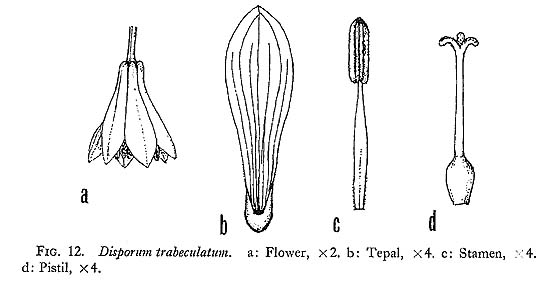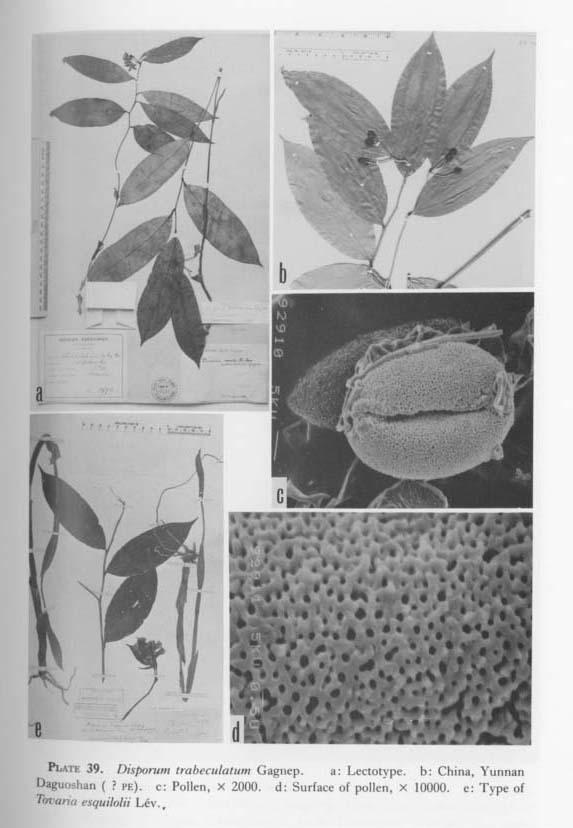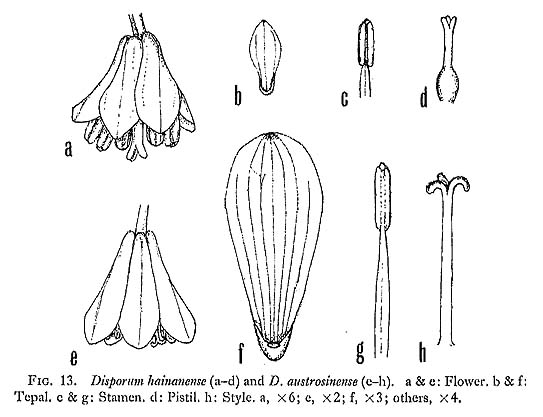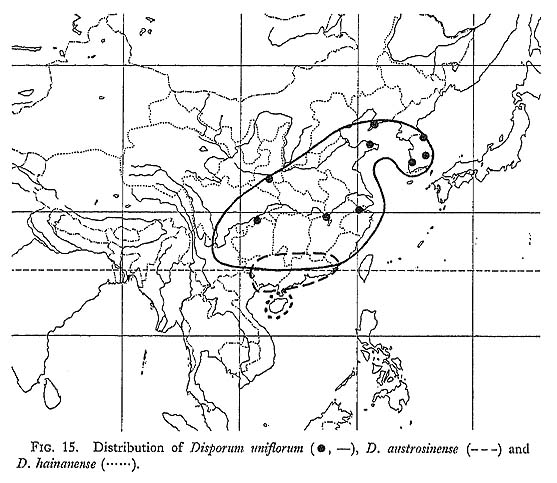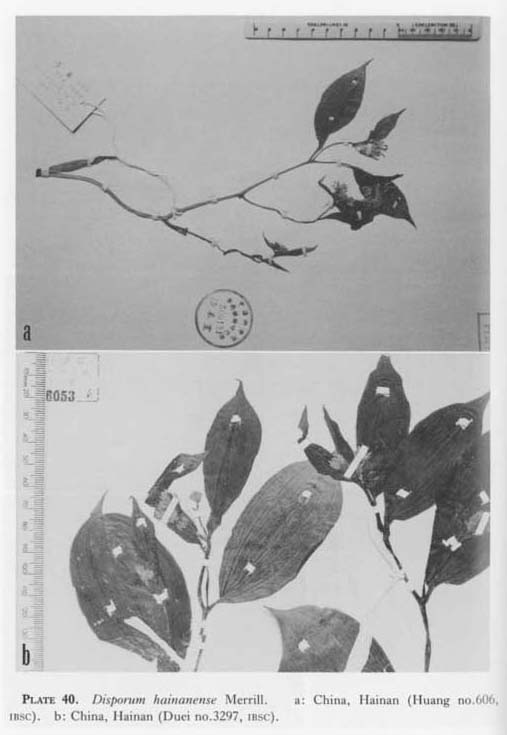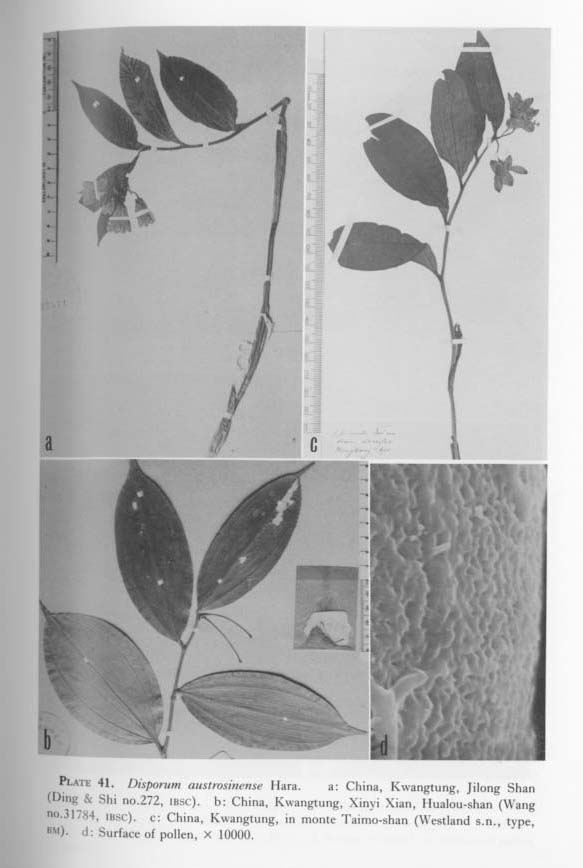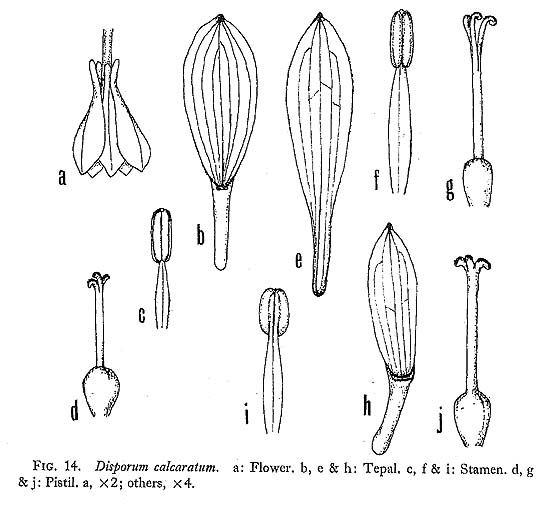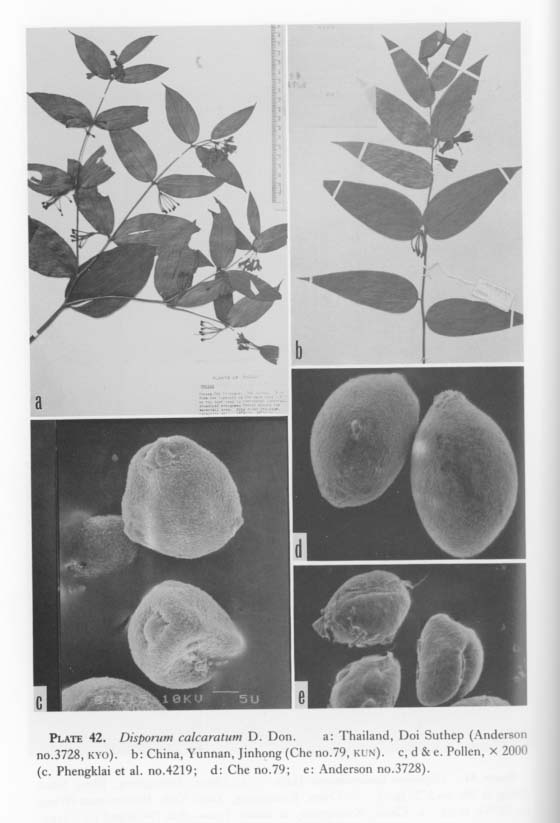A REVISION OF THE ASIATIC SPECIES OF THE GENUS DISPORUM (LILIACEAE)
Hiroshi HARA †
| ( 2 / 3 ) |
|
6) Disporum leucanthum Hara in Journ. Jap. Bot. 47: 114 (1972); in Fl, E. Himal. 3: 131 (1975); in Bot. Helvet. 94: 255, f. 1 (1984). [Plate 32; Figs. 1b, 7a-d, 8]
Rhizome creeping, with long slender creeping atolona 2-3 mm thick. Stem simple, rarely with one branch, 15-40cm high, 1.5-3 mm thick, glabrous, 3-6-leaved in the upper part, with 4-6 sheathing bracts in the lower part. leaves oblong or elliptic, 3-9 cm long, 1-4 cm wide, acute or acuminate at the apex, broad-cuneate or roundish at the base, glabrous, with flat cells on margin, 3-7-nerved; petiole short. Pedicels filiform, 1-22 mm long smooth. Flowers terminal, 1-4-fasciculate, nodding, white at anthesis, infundibuliform, widely opening, 1.5-3 cm in diameter, 3-4 mm across at the base. Tepals broad lanceolate, narrow ovate or spathulate, 12-20 mm long, 3-7 mm wide, acute at the apex, narrowed in the lower part, minutely papillose on the lower margin and inside, only slightly saccate at the base, 5-7-nerved. Stamens nearly as long as the tepals, sometimes shorter, 8-18 mm long; filaments (6)8-15 mm long, white glabrescent, very minutely papillose in the lower part; anthers 3.5-5 mm long, yellowish, slightly purplish when young. Ovary obovoid, 2.5 mm long, green. Style as long as or shorter than the tepals, 7-12 mm long, white, trifid at the apex. Fl. Apr.-May. Chromosomes 2n=16 (Kurosawa, 1983). In forests; East Himalaya (Darjeeling, Sikkim, possibly east Nepal, alt, 1000-2500 m), and West China (Szechuan, Yunnan). REPRESENTATIVE SPECIMENS. DARJEELING: Kurseong, 1550 m (M. Togashi no. 6602, Apr. 12, 1960, fl.-type of D. leucanthum Hara, TI); Sinchul, 7000 ft. (T. Andcraon no. 25776, May 1862, fl., CAL); Senchal (H. Hara & M. Togashi, Apr. 16, 1960, TI); Palmajua to Rimbick (H. Kanai et al., May 5, 1960, TI); Rimbick to Ramam (J. Sinclair no. 4142, Apr. 22, 1945, fl., E). SIKKIM: Choongtam 7-9000 ft. (J. D. Hooker, May 20, 1849, fl., K); Neirie, 5000 ft. (J. L. Lister, Apr. 1877, fl., CAL); Mahalderam (J. S. Gamble no. 10317, Apr. 1882, fl., K); above Rhikisum, 7100 ft. (C. C. Lacaita no. 15529, Apr. 25, 1913, fl., BM). WEST CHINA, Szechuan: Shihntuan-hsien (C. C. Hsieh no. 40064, 1955, fl., PE); Mt. Jmfo-ahan, Nanchuan-hsien, 1290 m (Xiong & Li no. 90719, May 7, 1957, fl., PE; sz). Yunnan: Summit of Shweli-Salwing divide, 8000 ft (K. Ward no. 215, Apr. 17, 1913, fl., E). In having turbinate flowers which are slightly constricted above the base, Disporum leucanthum forms a natural group with D. Bodinieri, D. tonkinense, and D. Leschenaul-tianum, which are distributed widely in India and China. Among those species, D. leucanthum is characterized by large white flowers, acute and smooth tepals, naviculate in the basal part, longer stamens with a filiform filament, longer anthers, and slender long creeping subterranean stolons. 7) Disporum tonkinense T. Koyama in Bot. Mag. Tokyo 71: 303, f. 1 (1958). [Figs. 7e-h, 8]
Rhizome short, creeping. Stem 20-40 cm high, simple or branched in the upper part, with 3-5 vaginate leaves in the lower part. Leaves ovate to elliptic, 2.5-6 cm long, 1.5-3 cm wide, acuminate at the apex, broad-cuneate at the base, smooth on margin, 5-7-nerved, subsessile or very shortly petioled. Inflorescence terminal, 3-5-flowered, subsessile. Pedicel 9-13 mm long, angulate, smooth. Flower open-campanulate, widely opening, ca. 1 cm in diameter, nearly white, ca. 3 mm in diameter at the base. Tepals ovate-oblong, 6-7 mm long, 2.5-3 mm wide, somewhat obtuse at the apex, carinate on the back, strongly naviculate in the lower part, papillose on lower margin, thickish, slightly saccate at the base, only 3-nerved. Stamens exsertcd; filaments 5-6 mm long, filiform, minutely papillose in the lower half; anthers narrow-oblong, 2.5-3 mm long, hardly apiculate. Ovary obovoid, 2-2.5 mm long. Style 4-6 mm long, trifid; branches 2-2.5 mm long. Berries globose, 6-9 mm in diameter, blue-black. Seeds ovoid, 4 mm in diameter, Fl. Jul. Specimen examined, TONKIN. Tamdao (B. Hayata s.n., Jul. 28, 1917, fl. & fr.-holotype D. tonkinense T.of Koyama, TI). The species is known only from the type material. From allied species, Disporum tonkinense differs by small whitish flowers, smooth pedicels, small 3-nerved tepals which are somewhat obtuse at the apex, 6-7 mm long, minutely papillose on lower margin, naviculate in the lower part, stamens slightly longer than tepals, and filiform filaments minutely papillose in the lower half. 8) Disporum longistylum (L×v. et Van.) Hara in Journ. Jap. Bot. 59: 40, f, 3 & 4 (1984). [Colour plate 8d; Plate 33; Fig. 9]
Tovaria longistyla L×v. et Van. in Mem, Pont. Acad. Rom. Nuovi Linc. 23: 361 (1905). Rhizome decumbent, without slender creeping stolons. Stems 30-90 cm high, usually branched in the upper part, Leaves lanceolate to elliptic, sometimes ovate, 3-10 (15) cm long, 8-45(60) mm wide, caudate-acuminate or attenuate to the apex, roundish at the base, dark green and slightly lustrous above, 3-7-nerved with inconspicuous transverse veinlets; petiole short, 3-10 mm long, slightly scabrous on margin. Inflorescence terminal, umbellate, (1)2-5(8)-flowered. Pedicels 6-25 mm long, angular, very slightly rugose on ridges. Flowers nodding, campanulate, 10-16(19) mm long, 10-13 mm in diameter, aubtruncate and 3.5-4.5 mm across at the base, light green or green-yellow-ish, rarely purplish. Tepals (8)10-15(17) mm long, (2)2.5-4(8) mm wide, spathulate-oblanceolate or obovate, acutish and mucronulate at the tip, naviculate and carinate on the back in the lower half, slightly gibbose (1-1.5 mm) at the base, 5-7-nerved, minutely papillose on margin. Stamens exserted, 12-19 mm long; filaments filiform, 10-16 mm long, greenish white, very minutely papillose-hairy in, the lower half; anthers linear, (2.5)3-4(5) mm long, obtuse at the tip, often reddish with deep yellow pollen. Ovary obovoid or oval, 2-3 mm long, green, with ascending ovules. Style generally exserted, 8-17 mm long, smooth, with 3 stigmatic branches 1-2(4) mm long. Berry subglobose or slightly depressed globose, 6-9 mm in diameter, black. Fl. Mar.-Jun. Fr. Sep.-Dec. Chromosome 2n=16 (Kurosawa, 1983, as D. Bodinieri). In forests, sometimes in rocky places, alt. 400-1800m; China (Hupeh, Shensi, S Kansu, Kweichou, Szechuan, Yunnan) and SE Tibet. REPRESENTATIVE SPECIMENS. CHINA. Kweichou: Pinfa (J. Cavalerie no. 1308, Mar. 15, 1902, 'fl. jaunes'-type of Tovaria longistyla Lév. et Van., E); Pinfa (J. Cavalcrie no. 648, Oct. 14, 1902, fr.-type of D. Cavaleriei Lév., E). Yunnan: Sous-bois des collines a Long-ky, 700 m(E. E. Maireno. 105,Jun.,fl,,E; BM). Szechuan: Chudian, m. Omei, 1750 m(K. H. Yang no. 54274, Apr. 29, 1957, fl., PE; sz); m. Omei (W. P. Fang no. 18557, Apr. 28, 1942, fl., PE); m. Omei (H. Hara, May 3, 1981, fl., TI); Baichi Shan, Chengkou-xian, 610m (T. L. Tai no. 103012, Sep. 23, 1958, fr., sz); Tienchuan-hsien, 2650 m (K. L. Chu no. 2514, May 7, 1936, fl., BM); Baiwuping, Nanchuan, 850 m (G. Li no. 60703, Apr. 23, 1957, fl., PE); Shin-mian-hsien (C. C. Hsieh no. 40193, 1955, fl., PE); Pingwu Xian, Lijiado, 1820 m (H. L. Tsiang no. 10229, May 15, 1958, fl., PE); Kang-ding, Dajinerlang-shan, Dajingping, 2200 m (Jiang no. 33954, Apr. 24, 1953, fl., PE). This species is allied to Disporum, cantoniense (Lour.) Merrill, but is distinguished by exserted stamens 12-19 mm long, filaments minutely hairy in the lower part, generally exserted style 10-17 mm long, light green flowers, acute spathulate-oblanceolate tepals 10-15 mm long and slightly gibbose at the base, and leaves caudate-acuminate at the apex. 9) Disporum megalanthum Wang et Tang in Fl. Reip. Pop. Sin. 15: 45 & 250, t. 16.1 (1978). [Plate 34; Fig. 10]
Rhizome short, with coarse roots 2-3 mm thick. Stems 30-60 cm high, generally branches in the upper part. Leaves ovate to lanceolate-ovate, 6-12 cm long, 2-5(8) cm wide, acuminate or long-attenuate to the apex, roundish at the base, shortly petiolate, minutely papillose-scabrous on margin. Inflorescences opposite to a leaf or terminal on a short lateral branchlet, subumbellate, (2)3-8 (9)-flowered, sessile or with short peduncle up to 2.5 cm long. Pedicels slender, 10-20(27) mm long, longitudinally ridged, almost smooth. Flowers nodding, open-campanulate, (20)22-38 mm long, white or creamy, half-opening and 12-20 mm in diameter in the upper part, narrowed to the base 2.5-4 mm in diameter. Tepals obovate-lanceolate, 20-38 mm long, 5-8 mm wide, shortly acutish at the apex, shortly (ca. 1 mm long) saccate at the base, minutely papillose on margin and inside in the lower part. Stamens slightly shorter than the tepals; filaments 12-20 mm long; anthers (3)5-6 mm long. Ovary ca. 3 mm long; style 10-17 mm long, trifid at the apex, branches 2-4 mm long. Berries subglobose, 6-15 mm in diameter, ? blue-black. Seeds globular, 2-4 mm in diameter, brownish. Fl. Apr.-Jul. Fr. Aug.-Oct. In forests or grassy places, alt. 1500-2350 m; China (Hupeh, S Shensi, S Kansu, Szechuan) and SE Tibet. REPRESENTATIVE SPECIMENS. CHINA. Hupch: Hsin-shan, Laoyan-shan, 1600 m (Y. Liu no. 498, May 27, 1957, fl. white-type of D. megalanthum Wang et Tang, PE); Hsing-shan Hsien, 1-4000 ft. (E. H. Wilson no. 3230, Jun. & Oct. 1907, fl. & fr., BM). Kansu: Chagola, Fun Shan, Ling & Gohoba, 6500 ft. (Farrer & Purdom no. 60, May 6 & 12, 1914, fl., E; KYO). Szechuan: Mt. Omeishan (K. H. Yang no. 54477, fl., PE); Mt, Omei, 2350 m (Guan et al. no. 381, May 9, 1964, fl. white, PE); Wu-shan Xian, Chao-yang-ping, 2000 m (G. H. Yang no. 57939, May 3, 1958, fl. white, PE); Kang-ding, Dajinerlang-shan, Dajingping, 2200 m (Jiang no. 33944, Apr. 24, 1953, fl. white, PE); O-pien Hsien, 2000m (T. T. Yü no. 629, May 4, 1932, fl. white, PE). SE TIBET. Tsarong, Salwin-Kiu Chiang, west of Sikai (Forrestno. 21660, fl., E); Rima, 7-8000 ft. (F. Kingd.-Ward no. 19320, Apr. 9, 1950, fl. cream, BM). This species is closely allied to Disporum cantoniense, but has larger half-opening flowers which are narrow at the base (about 3 mm in diameter), broader tepals, longer filaments, longer anthers 5-6 mm long, and longer style. The dimensions of the floral parts correspond to D. cantoniense var. sikkimense Hara, but it differs from the latter by the shape of the flowers with a narrow base, and longer anthers. 10) Disporum cantoniense (Lour.) Merrill in Philip. Journ. Bot. 15: 229 (1920); in Trans. Amer. Philos. Soc., n.s. 24 (2); 109 (1935-Jessop in Fl. Males. 9:218 (1979), excl. D. Leschenaultianum et D. calcaratum-Hara in Bot. Helvet. 94: 257 (1984). [Colour plate 7b, c; Plate 35-38; Fig. 11]
Fritillaria cantomensis Lour., Fl. Cochinchin. 1: 206 (1790). Disporum cantoniense is the most widespread species in the genus, and is distributed in the Himalayas east to China and south to Malaysia. It is a variable species, and can be divided into 4 geographical varieties as follows:
10a) var. cantoniense. [Colour plate 7c; Plate 35; Fig. 11a, b, d, e] Uvulariachinensis Ker-Gawl. in Curtis, Bot. Mag. 23: t. 916 (1806); 37: sub t. 1537 (1813). Rhizome thick, short, without long slender creeping stolon, often thrive through winter. Stem erect, 50 cm-1 m high, generally branched in the upper part, green, terete except for the upper branchlets. Leaves lanceolate to ovate-lanceolate, 5-12 cm long, 1-5 cm wide, long-attenuate to the apex, broad-cuneate or roundish at the base, 3-7-main-nerved, with inconspicuous transverse veinlets, scabrous on margin, shortly petioled. Inflorescence often pseudo-terminal on short branchlets opposite to a leaf, 2-7(10)-flowered, often sessile, sometimes pedunculate, with a peduncle up to 3 cm long. Pedicels 0.5-3.5(4) cm long, angulate, papillose-scabrous or almost smooth. Flowers nodding, campanulate, slightly opening in the upper part, 10-20 mm long, 8-12 mm in diameter, often brown-purplish, 4-5 mm in diameter at the base. Tepals oblanceolate or spathulate, 12-16 mm long, 3-5 mm wide, acutish, with a keeled midrib, shortly (2-3 mm long) gibbose at the base, slightly papillose on lower margin and inside in. the lower part. Stamens shorter than tepals, 8-1 mm long; filaments 7-8 mm long, slightly thickened and minutely papillose in the lower part; anthers oblong, 2-4 mm long, yellowish, scarcely apiculate, almost basifix, extrorse. Ovary obovoid, ca. 3 mm long, green. Style 7-15 mm long, whitish, sometimes purplish, trifid in the upper part; branches 3-4.5 mm long. Berries slightly depressed globose, 6-8 mm long, 8-10 mm in diameter, blue-black, generally 2-3(5)-seeded. Seeds subglobose, 4-6 mm long, 3-5 mm in diameter, brownish, smooth. Fl, May-Jul. Fr. Aug.-Dec. Chromosomes 2n=14, 16 and 30 (Kurosawa, 1966 & 71; Sen, 1973-75). Himalaya (Simla, east to NEFA), Assam, Manipur, N Burma, N Thailand, Indo China, and China; alt, 700-3000m. REPRESENTATIVE SPECIMENS. GARHWAL (Golla no. 2095, fl.,BM); Ramni, 2500 m (M. A. Rau no. 10096, Jun. 10, 1959, TI). NEPAL. *Chitlong (Buch,-Hamilton, Apr. 11, 1802, sub Uvularia Pisuta, fl.-holotype of Streptopus peduncularis Smith, LINN-SMITH HERB). 586; type of D, Pitsutum D. Don, BM); *Napalia (Wallich, Maio 1818, fl.-type of Uvularia parviflora Wall,, BM); *Napalia (Wallich, 1819, fl.-lectotype of Uvularia umbellata Wall., BM); *Napalia (Wallich no. 5090 Uvularia unbellata, 1821, fl., K-W); *Napalia (Wallich no. 5091 Uvularia parviflora, 1821, fl., K-W); *Phulchoki, Kathmandu (H. Ohashi & H. Ohba no. 723541, May 28, 1972, fl,, TI); *Ranga Pani-Ghorwa (H. Hara et al., Dec. 9, 1963, fr., TI); near Dharan, 3700 ft. (L. H. J. Williams no. 90, BM); Simigaon (McCosh no, 169, fl., BM). DARJEELING; *Batassi, 2000 m (H. Hara et al. no. 6599, May 2, 1960, fl., TI). SIKKIM: *Yoksam-Dentam, 1700-2500 m (H. Hara et al., May 18, 1960, fl., TI); *Chiabanjan Dentam (H, Hara et al. no. 6600, May 11, 1960, fl., TI). BHUTAN: (Griffith no. 2647, BM); *Chima Khothi, 2050 m (H. Kanai et al., Jun. 1,1967, fl., TI); *Tamji, 2000 m (H. Hara et al.,
May 11,1967, fl., TI); Bhotokha-Rinchu, 1300 m (H. Kanai et al. no. 14531, May 8, 1967, fl., TI); 1 km SW of Tongsa, 2100 m (Grierson & Long no. 1184, May 20, 1979, fl., TI). BURMA: North Triangle, 3000-5000 ft. (F. K.-Ward no. 20792, May 7, 1953, fl., BM). THAILAND: Hoet That-Muong Khu (H. Ogawa et al. no. 216-82, Feb. 16, 1958, TI). LAOS: Sam-vena (M. Poilane no. 1965, Sep. 24, 1920, P, PE) ; 20 km NE of Phonsavanh (T. Tuyama no. 57192, Dec. 29, 1957, TI). ANNAM: Dalat (B. Hayata, Jun. 7, 1921, fl., TI). CHINA. Yunnan: Ami (Y. Tsiang no, 13106, Feb. 9, 1934, TI); Kunming, Taihwa-shan, 2000-2300 m (Y. Tsiang no. 11243, Jul. 20, 1933, TI); Xishan, Kunming (H. Hara, May 15, 1981, fl., TI); Huadianba, Tali, 2900-3100 m (K. Iwatsuki et al. no. 1395bis, Aug. 28, 1984, TI). Szechuan: Shimian Xien (C. C. Hsieh no. 40691, 1955, PE). Kweichou: Lion-chon-down, Anshun (? no. 148, Apr. 30, 1935, fl., PE). Kwangsi: Chiu Tung, Ling Yün Hsien (Steward & Cheo no. 334, May 6, 1933, PE). Kwangtung: Ting Wu Shan (W. Y. Chun no. 6495, May 7, 1928, fl., PE); Yangshan Xian, 650 m (L. Tang no. 1004, May 25, 1956, fl., PE). Hunan: Lanshan Xian, Suocheng (Zhong no. 810, fl., PE). JAPAN. HONSHU. Koishikawa Bot. Gard., Tokyo, cult, (J. Matsumura ?, Jun. 22, 1880, fl., TI); Disporum cantoniense var. cantoniense f. brunneum (C. H. Wright) Hara, comb. et stat. nov. Tepals large, oblanceolate, about 28 mm long, 6 mm wide, acuminate at the apex, brown-purplish, spreading in the apical part, scabrous on margin. The original plant was grown in London from a seed collected by E. H. Wilson in Western Hupeh of Central China. The following specimens from Central China which have large purple flowers, and acute tepals about 3 cm long can be referred to this form: Disporum cantoniense var. cantoniense f. parviflorum (Wall.) Hara, comb. et stat. nov. Leaves linear-lanceolate to lanceolate-ovate. Pedicels 1-3 (4) cm long, minutely papillose. Flowers 15-20 mm long, generally greenish or creamy white. Tepals acute at the apex, minutely papillose on margin, shortly (1-1.5 mm long) gibbose at the base. Anthers 2-3 mm long. Style 6-8 mm long, with shortly trifid stigma. This form prevails in the Himalayan region, and differs from the typical f. cantoniense chiefly by longer pedicels 1-4 cm long and minutely papillose, slightly larger greenish flowers, and acute tepals shortly gibbose at the base. But transitional forms are often found in Himalaya and western China. Representative specimens of f. parviflorum were marked with an asterisk (*) cited under var. cantoniense. In this form, the shape of leaves is very variable. The type of Uvularia parviflora Wallich (BM) has narrow lanceolate leaves, small flowers less than 1 cm long, very short filaments, anthers and styles, and the flowers seem to be not fully developed as yet. The type of Uvularia umbellata Wallich (BM) has narrow linear-lanceolate leaves 5-13 mm wide, and umbellate 3-6 (10)-flowered inflorescence. Whereas the types of Streptopus peduncularis Smith and Disporum Pitsutum D. Don have broader lanceolate-ovate leaves up to 35 mm wide, and often elongate peduncles up to 2 cm long. Uvularia umbellata illustrated by Wallich and a part of Wallich no. 5091 are near to these forms, but the leaves are slightly elongate and narrower. These broad-leaved forms are common in East Himalaya, Burma, and China. The Himalayan plants are cytogenetically variable also, three different chromosome numbers 2n=14,16 and 30 (Kurosawa, 1966 & 71; Sen, 1973-75), and several different karyotypes have been reported. The cytotype with 2n=14 chromosomes has hitherto been found from east Nepal, Darjeeling, west Bhutan, and Shillong, one with 2n=16 chromosomes from Kathmandu, Darjeeling, and Mussooree, and one with 2n=30 chromosomes from central Nepal and Darjeeling. The primary basic chromosome number seems to be 8, and x=7 can be derived from 8, and 2n=30 may be amphidiploid originated from x=7 and 8. But the relationship between morphological and other phenotypic characters and cytogenetical genotypic characters has not been studied in detail. For the present it is difficult to discuss infrageneric taxa of Himalayan Disporum cantoniense, further studies based on more ample material from different regions are much needed. 10b) Disporum cantoniense var. Kawakamii (Hayata) Hara, comb. et stat. nov. [Plates 36, 37] Disporum Kawakamii Hayata in Journ, Coll. Sci. Univ. Tokyo 30 (1); 365 (1911)-Chao et al. in Bot. Bull. Acad. Sin., n.s. 4; 81 (l963)-Liu et Ying in Fl. Taiwan 5: 52, t.1279 (1978). Stem 50-100 cm high, branched in the upper part. Leaves lanceolate, oblong-lanceolate, sometimes ovate, 4-17 cm long, 8-50 mm wide, acuminate or long-attenuate to the apex, cuneate to roundish at the base, slightly scabrous on margin, shortly petiolate. Inflorescence pseudo-lateral opposite to a leaf, 2-5-flowcred, sessile or very shortly pedunculate. Pedicels 6-20(40) mm long, angulate, almost smooth. Flowers campanu-late, white-greenish or dark purple in the upper part and at the base, 4-5 mm in diameter at the base. Tepals oblanceolate or apathulate, 18-21 mm long, 3.5-6 mm wide, shortly acute and densely papillose at both sides in the apical part, long-attenuate to the base, gibbose at the base, minutely papillose on lower margin and inside in the lower part. Stamens shorter than tepals, 10-20 mm long; filaments 8-12 mm long, very minutely papillose in the basal part; anthers (2.5) 3-4 mm long, mucronulate and minutely papillose at the tip. Ovary ca. 3 mm long. Style 8-14 m long, minutely papillose in the upper part, shortly trifid at the apex. Berries depressed globose, 8-10 mm in diameter, blue-black Fl. Mar.-May. Chromosomes 2n=16 or 32 (Hsu, 1971). In montane forests, alt. 1300-2100 m; in Taiwan. REPRESENTATIVE SPECIMENS, TAIWAN. Taipei: Urai (U. Faurie no. 940, Apr. 1914, fl., TI). Taoyuan: Fusing (C. M. Kuo, May 10, 1979, fl., TI). Ilan: Mt. Nanhutashan (T. Yama-zaki no. 622, Aug. 20, 1969, TI). Hualien: Tainokaru, 300 m (K. Inoue et al. no. 1907, Mar. 24-25, 1977, fl., TI); Kenkai-gun, Tabito to Tausai (H. Shimada no. 1305, Jul. 7, 1927, TI). Taichung: Chutoko (T. Kawakami & U. Mori no. 1210, Aug. 3, 1906, TI); Keitao (B. Hayata, Apr. 11, 1916, fr., TI). Nantou: Musha, 4000 ft. (B. Hayata, Apr. 19, 1916, TI); in monte Morrison, 7000 ft. (T. Kawakami & U. Mori no. 1726, Oct. 13, 1906, young fr.-syntype of D. Kawakamii Hayata, TI); ibid. (G. Nakahara no. 1965, fr., TI). Taitung: Antung spa-Haianshanmo (T. Namba et al. no. 2045, Aug. 14, 1968, fr., TI). Chiayi: Kagi, Suitoryo (T. Kawakami no. 349, Mar. 20, 1908, fl.-lectotype of D. Kawakamii Hayata, TI). Pingtung: Sintaiwu-Mt. Tawushan, 1000-1670 m (T. Namba et al. no. 275, Jul. 16, 1968, TI); Mt. Peitawushan, 1480-2000 m (T. Namba et al. no. 518, Jul. 17, 1968, TI). 10c) Disporum cantoniense var. multiflorum (Blume) Hara, comb. nov. [Plate 38a, b; Fig. 11c] Uvularia multiflora Reinw., Cat. Pl. Buitenz. 62 (1823), nom. nud. Stem 40-80 cm high, up to 2.5 m high, branched in the upper part. Leaves ovate-lanceolate, ovate or lanceolate, 6-17 cm long, 2-9 cm wide, generally abruptly long-acuminate at the apex, roundish or obtuse at the base, shortly petiolate. Inflorescence subumbellate, 2-7-flowered, generally long-pedunculate (1-3.5 cm long). Pedicels slender, 1-4.5 cm long, angulate, minutely papillose on ridges. Flowers often purplish or violet, sometimes whitish or greenish, Tepals spathulate or oblanceolate, acute, 1-2 (2.5) cm long, 3-4(5) mm wide, minutely papillose on margin, with short spur 1.5-2 mm rarely up to 3 mm long. Filaments 6-10 mm long, almost smooth; anthers 2.5-3(4) mm long, yellow. Ovary obovate, ca. 3 mm long. Style 7-9 mm long, trifid at the apex. Berries depressed globose, 7-10 mm in diameter, blue-black. Fl. Jan.-Dec. In montane forests; in Malaysia (Sumatra, Java, Bali, 700-2550 m) and Malay Peninsula (Perak, Pahang, 1000-2700 m). REPRESENTATIVE SPECIMENS. SUMATRA. Kem Pawang, Upper Mamas R. valley, W of Kutacane, 1250 m (de Wilde et al, no. 18203, Jun. 29, 1979, KYO); Sidulang, N Tapanuli (S. Yoshida no. 57, Feb. 4, 1971, KYO). JAVA. Kletak, 1500 m (? no. 160, Sep. 4, 1912, fl., L); Nongko djadjar, 1250 m (J. P. Mousset, 1911, fl., L); Baturaden to Gunung Slamet, 2000-3000 m (G. Murata et al. no. 710, Aug. 19, 1973, fr., KYO; TI); Gede, 1300-1500 m (H. Okada no. 3437, May 15, 1981, fl., KYO). MALAYA. Cameron Highland, m. Brinchang, 1900 m (M. Togashi, Mar. 5, 1970, TI). This variety is characterized by generally long-acuminate broad leaves, long slender pedicels and peduncles, often purplish flowers, more pointed tepals, and short spur sometimes up to 3 mm long. 10d) Disporum cantoniense var. sikkimense Hara in Bot. Helvet. 94: 258, f. 2 (1984). [Colour plate 7b; Plate 38c; Fig. 11f-h] Inflorescence generally terminal on branches, umbellate, sessile, 3-7-flowercd. Pedicels slender, 18-30 mm long, minutely papillose. Flowers nodding, narrow cam-panulate, yellowish-greenish, 2-3 cm long, truncate and 5-6 mm in diameter at the base. Tepals broad lanceolate, 20-32 mm long, 4-10 mm wide, long-acuminate at the apex, shortly (less than 2 mm long) gibbose at the base, strongly keeled outside in the lower part, slightly papillose on the lower margin. Stamens ca. 2 cm long; filaments 13-17 mm long, whitish, smooth, ca. 2 mm wide above the base; anthers oblong, 3.5-4.5 mm long. Ovary obovoid, ca. 4 mm long; style 1.8-20 mm long, shortly trifid at the apex. Fl. May-Jun. Fr. Oct.-Nov. Chromosomes 2n=16 (Kurosawa, 1983). In forests, alt. 1800-2200 m; in Eastern Himalaya (Nepal, Sikkim, Bhutan). REPRESENTATIVE SPECIMENS. SIKKIM: Tendong, collected in Jun. 1969 and cultivated in Karuizawa, Nugano Pref, (H. Hara, May 16, 1972, fl.-type of D. cantoniense var. sikkimense Hara, TI; May 21, 1983, fl., TI); Damthang, above Temi, 6000 ft, (C. C. Lacaita no. 15556, May 2, 1913, fl,, BM). BHUTAN: Dengchung (Ludlow, Sheriff & Hicks no. 18761, fl., BM). This variety has much larger flowers 2-3 cm long, long-acuminate tcpals, longer stamens, and longer style which has short trifid stigmas, and looks very different from typical var. cantoniense (including f. parviflorum), But these varieties are considerably variable, in Himalaya and China, and some specimens such as Nepal (O. Polunin no. 43, BM; E) and Bhutan (Ludlow, Sheriff & Hicks no. 18761, BM & no. 20541, BM; E) show somewhat intermediate characters between them. On the other hand, var. sikkimense resembles Disporum inegalanthum Wang et Tang from West China (cf. pp. 182-183). 11) Disporum trabeculatum Gagnep. in. Bull. Soc. Bot. France 81: 286 (Jun. 1934); in Fl. Gén. Ind.-Chin. 6: 783 (Nov. 1934). [Plate 39; Fig. 12]
? Tovaria Esquirolii Lév, in Fodde, Repert. 6: 264 (1909); non Disporum Esquirolii Lév.(1907). Rhizome hard, without long creeping stolon. Stems sometimes caespitose, 30-80 cm high, simple or branched in the upper part. Leaves oblong or elliptic, 8-14 cm long, 2.5-5.5 cm wide, generally abruptly acuminate at the apex, roundish or broad-cuneate at the base, later thick and crisp-undulate on the margin, glabrous, with 3-5 primary veins and distinct transverse veinlets; petiole distinct, 5-10 mm long, smooth, canalic-ulate above. Inflorescence terminal, umbellate, 2-5-flowered, sessile. Pedicels slender, 10-30 mm long, angulate, almost smooth. Flowers broad-campanulate, whitish, 3-4mm across at the base. Tepals spathulate-oblanceolate, 10-16 mm long, 3-5 mm wide, obtuse or acutish at the apex, long-attenuate to the base, gibbose at the base, minutely pilose on margin and inside in the lower part. Stamens nearly as long as tepals; filaments 5-9 mm long, 0.7-1 mm wide, minutely papillose in the lower part; anthers 3.5-4.5 mm long. Ovary obovoid, 2-2.5 mm long; style 5-7(8) mm long, 3 lobed at the apex. Fruits globose, blue-black in mature, 10-12 mm in diameter. Fl. May-Jun. In forests; Vietnam (Tonkin, Annam, alt. 500-1900 m) and West China (S Yunnan, ? Kweichou). REPRESENTATIVE SPECIMENS. VIETNAM. Annam: Vallée de la riviére de Cubi, prov. Quangtri (Eberhardt no. 1970, fl, 'blanche'-lectotype of D. traveculatum Gagn., P) ; ibid. (Eberhardt no. 2066, fl., P); Bana, près Tourane, 1200 m (Poilane no. 7173, Jul. 14, 1923, fr., P); SE de Langkhoai, prov. Quangtri, 500 m (Poilane no. 11101, Jun. 29, 1924, fr., P); Col. des Nuages, près Tourane, 7-800 m (Poilane no. 8005, Sep. 14, 1923, fr., P); Tourane, Mt. Bana (J, & M. S. Clemens no. 4163, Aug. 16, 1927, fr., P). TONKIN: Chapa (Pételot no. 2915, Apr. 1925, young fr., P); massif de Losuitong près Chapa, 1800 m (Poilane no. 12647, Jun. 29, 1926, fr., P); Chapa (B. Hayata, Jun. 27, 1917, defl,, TI); Lisaba, near Laojie, 1240-1995 m (Anon. no. 272, Dec. 10, 1964, fr., KUN). CHINA. S Yunnan: Gangdong, Dinghu Shan, 900 m (K. C. Ting & K. L. Shi no. 2039, Jun. 13, 1965, KYO). ? Kouy-tchéou (J. Esquirol no. 911, fl. 'blanche'-type of Tovaria Esquirolii Lév., E). This species is characteristic in having thicker adult leaves with distinct transverse veinlets and crisp-undulate margin, distinct petiole, with abruptly acuminate apex, terminal inflorescence, and less-branched stem. In the original description, the calcar is '3 mm long', but the type material at Paris has short spur only about 1 mm long. The type specimens of Tovaria Esquirolii Lév. consist of young flowering stems, and one leafy stem of the previous year. The foliage agrees with that of D. traveculatum, but several flowers are crowded as in D. cantoniense, and the filaments are glabrous. More materials are needed to fix the exact status of this plant. Tovaria Esquirolii Lév. has nothing to do with Disporum Esquirolii Lév. (1907) which actually belongs to the genus Tricyrtis. 12) Disporum hainanense Merrill in Philip. Journ. Sci. 21: 338 (1922); in Lingn. Sci. Journ. 5: 47 (1927)-Masamune, Fl. Kainan. 403 (1943)-Fl. Hainan 4: 116, f. 1023 & 533 (1977). [Plate 40; Figs. 13a-d, 15]
D. sanpomonticolum Yamamoto, Contr. Fl. Kainan 1: 28 (1943). Stem 15-100 cm high, simple or branched in the upper part. Leaves elliptic or ovate, sometimes broad-lanceolate, 6-13 cm long, 2-5.5 cm wide, abruptly acuminate at the apex, obtuse or cuncate at the base, 3-7-nerved, slightly rugose on margin, transverse veinlets sometimes distinct; petioles distinct, 4-10 mm long, canaliculate. Inflorescence terminal, 3-5-flowered, umbellate, sessile or shortly pedunculate. Pedicels 5-22 mm long, longitudinally ridged, glabrous. Flowers half-opening, campanulate, 7-15 mm in diameter, white, rosy or yellow and maroon, fragrant, ca. 2.5-3 mm in diameter at the base. Tepals obovate-cuneate, (4.5)5-9(10) mm long, 2-4 mm wide, roundish at the apex, minutely mucronulate, narrowed in, the lower part, slightly ventricose and keeled outside at the base, cellulate on margin. Stamens slightly exserted, (6)7-9 mm long; filaments (3)4-6(8) mm long, very minutely papillose in the lower part; anthers oblong, 3-4 mm long. Ovary ellipsoid, 2-2.5 mm long; style slightly exserted, (3)4-7 mm long, trifid at the apex. Berries subglobose, 6-9 mm in diameter, black. Fl. Dec-May. In forests in ravines, alt, 500-1000 m; Hainan and S Kwangtung. SPECIMENS EXAMINED. HAINAN; Five Finger Mt., 800 m (F. A. McClure no, 9505, May 9, 1922, defl.-paratype of D. hainanense Men., TI); Baoting Xian, Diaoluo-shan, 900 m (Duei no, 3297, Dec, 24, 1954, fl., PE; IBSC); Hungmo-shan (Tsang & Fang no. 615, Aug. 2, 1929, PE); Chim Fung Ling, near San Mo Watt village (S. K. Lau no. 3819, Apr. 19, 1934, IBSC); Ya-Xian, Xiaobaohong (Liang no. 62679, Aug. 18, 1933, fr., IBSC); Danshui, Nanqiao (L. Tang no, 2746, Oct. 20, 1956, fl., IBSC). The species is allied to Disporum cantoniense, but has smaller often white or rosy flowers, shorter obovate tepals ventricose at the base, slightly exserted stamens, and elliptic leaves generally with abruptly acuminate apex, and broad-cuneate base. In order to fix the exact status of the species, it is essential to study more flowering material of this group from Hainan and Kwangtung. 13) Disporum austrosinense Hara, sp. nov. [Plate 41; Figs. 13e-h, 15]
D. Leschenaultianum D. Don sensu Hance in Journ. Bot. 25: 13 (1887)-C. H. Wright in Journ. Linn. Soc. 36: 142 (1903). Rhizoma decumbens. Caulis 20-60 cm altus, simplex, interdum pauce ramosus. Folia oblonga, elliptica vel ovati-lanceolata, 6-12 cm longa, 2-5 cm lata, apice abrupte acuminate vel acuta, basi rotundata vel late cuneata, supra viridia et luciduscula, infra purpurascentia, margine minute cellulata, 3(5)-venosa, nervulis transversalibus distinctis; petiolus brevis 3-6 mm longus. Inflorescentia terminalis, (2)3-4(5)-flora, umbellata, sessilis vel breviter pedunculata (5-8 mm longa). Pedicelli 8-20 mm longi, longitudinaliter costati. Flores aperte campanulati, 12-20 mm longi, apice 10-18 mm in diametro, basi ca. 4mm in diametro; aibi, saepe purpurascentes vel lutcscentes. Tcpala obovati-spathulata, 13-20 mm longa, 4-7 mm lata, apice rotundata, basi attenuata, margine inferiore minute papillosa, basi vcntricosa. Stamina tepalo breviora; filamenta 7-9 mm longa, inferiore minutissime papillosa; antherae 3.5-5 mm longae, apice minute apiculatae. Stylus tepalo aequilongus, 10-14 mm longus, apice breviter tri-lobatus. Fl. Mar.-Apr. Typus: Kwangtung: in monte Taimo-shan, adversus Hongkong (A. B. Westland, Apr. 1885, Herb, Hance no. 14479, fl., BM). In forests; South China (Kwangtung, Kwangsi, ? Fukien). SPECIMENS EXAMINED. CHINA. Kwangtung: Hushan, Jilong Shan (Ding & Shi no. 1364, Mar. 24, 1964, fl., IBSC); ibid, (Ding & Shi no. 272, Apr. 1963, fl., IBSC); Sam-kok Shan, Chan-woh-tung village (W. T. Tsang no. 25256, May 1935, fl., IBSC); Xinyu Xian, Hualoushan (C. Wang no. 31784, Mar. 22, 1932, fl., IBSC; no. 40811, Mar. 1, 1937, fl., IBSC); Xinyi, Daiwu-shan (Gao no. 51221, Mar. 25, 1931, fl., IBSC); Qujiang (Gao no. 50294, Apr. 3, 1930, fl., IBSC). Kwangsi: Longsheng (Exped, no. 7, Apr. 6, 1955, fl., PE; IBSC). Disporum austrosinense has somewhat intermediate characters between D. uniflorum Baker, and D. hainanense Merrill or D. traveculatum Gagn, It differs from D. uniflorum in having 3-4 flowers in an umbel, white or purplish tepals roundish at the apex, and adult leaves often with distinct transverse veinlets as in D. traveculaturm. It was once referred to D. Leschenaultianum, but clearly differs from the latter in having larger flowers, obovate-spathulate tepals with a roundish apex and keeled on the back, longer anthers and style, and less branched stems. 14) Disporum calcaratum D. Don in Proc. Linn. Soc. Lond. 1: 45 (1839); in Trans. Linn. Soc. Lond. 18: 516 (1841)-Kunth, Enum. Pl. 4: 207 (1843)-Baker in Journ. Linn. Soc. 14: 588 (1875)-Hook. f., Fl. Brit, Ind. 6: 359 (1892)-Hara in Enum. Flow. Pl. Nepal 1: 72 (1978). [Plate 42; Fig. 14]
Uvularia calcarata Wall., Cat, 178, no. 5087 (1832), nom, nud. Stems 30-80 cm high, sometimes up to 1 m high, generally branched in the upper part, rarely simple, Leaves oblong, elliptic, ovate-lanceolate or ovate, 5-13 cm long, 2-6 cm wide, shortly acuminate or acute at the apex, roundish at the base, 7-15-veined, without distinct transverse veinlets, minutely scabrous on margin and on main veins beneath; petioles generally distinct, 3-6(7) mm long. Inflorescence terminal on short lateral branches, subumbellate, (2)3-10-flowered, subsessile, sometimes with a peduncle up to 18 mm long. Pedicels 10-20(25) mm long, ridged, very minutely papillose on ridges or almost smooth. Flowers nodding campanulate, greenish white to dark purple, or pink. Tepals oblanceolate to narrow obovate, (10)12-22 (28) mm long including spur, 3-5 mm wide, acute or shortly acuminate at the apex, very minutely papillose on margin, with elongate spur at the base; spur 4-6 mm long, ca, 1 mm thick,obtuse at the tip, sometimes slightly recurved. Stamens slightly shorter than the tepals; filaments 3-8(10) mm long, ca. 1 mm thick, slightly rugose; anthers (2)4-6 mm long. Ovary obovoid, 2.5-3.5 mm long; style 5-10 mm long, trifid at the apex, sometimes to the middle, with branches 1-5 mm long. Fruits subglobose, ±10 mm in diameter, dark blue in mature. Seeds subglobose, 3-5 mm in diameter. Fl. Jun.-Jul. Fr. Sep.-Nov. Chromosomes 2n=16 or 18 (16+2B?). In evergreen forests or deciduous montane woods sometimes on limestone; Eastern Himalaya (Nepal to Bhutan), Assam, N Burma, Thailand (alt. 450-1200 m), Vietnam, and S China (S Yunnan, alt. 950-2400 m). REPRESENTATIVE SPECIMENS. NEPAL: C Nepal (Wallich no. 5088B, 1821, fl.-type of D. Wallichii D. Don, K-W); Sheopore (Wallich, 1819, BM); Arum Valley, E Nepal, 1500m (J. D. A. Stainton no. 779, Jun. 29, 1956, fl., BM); Morang Hills (Buch.-Hamilt., Jun, 1810, Wall. no. 5088A, fl.-type of D. Hamiltonianum D. Don, sub Uvularia Betua Hamilt., K-W). SIKKIM: 7000 ft. (Hook. f., K). ASSAM: Jentya Hills, Sylhet (G. Gomez, Wall. no. 5087-type of D. calcaratum D. Don, K-w); in mont. Silhet (Silva, Wall. no 5088C, fr.-syntype of D. Wallichii D. Don, K-W). N BURMA: Shan hills, 4000ft. (H. Collett no. 808, May 1888, fl.-type of D. latipetalum Collett et Hemsl., K); Khani (J. C. Prazcr, Jun. 1888, fl., BM); Kheekhlei (J. C. Prazer, Jun. 1888, fl., BW); N Changyang, 1500 ft. (R. Kaulback no. 181, Jun. 25,1939, fl. greenish white, BM). THAILAND: Chiang Mai, Doi Suthep, 650 m (E. F. Anderson no. 3728, Jul. 16, 1976, fl., KYO); Ob Luang table-land, 1000 m (Beusekom & Phengkhlal no. 1097, Jun. 11, 1968, fl. dirty purple, KYo);Kongloi, 900 m (Phengklai et al. no. 4212, Jun. 29,1978, fl. greenish white, KYO); Kanchanaburi, 750m (Beusakom et al. no. 3675, Nov. 11, 1971, fr., KYO). CHINA. Yunnan: Nanchiao, 1450 m (C. W. Wang no. 75196, Jun. 1936, PE); ibid., 1350 m (C. W. Wang no. 75047, Jun. 1936, fl., PE); Cheli-xian, Youlauch-shan, 1270 m (C. W. Wang no. 78071, Sep. 1936, fl. red, PE); Jinhong, Jiangnei, 950 m (Che no. 79, Aug. 24, 1958, fl., KUN); Xishuangbanna, Menghai, 1360 m (Mao no. 7075, Nov. 5, 1955, fr., PE). Disporum calcaratum differs from a polymorphic species, D. cantoniense, not only by longer slender spurs 4-6 mm long, but also by biporate pollen grains, and shortly acuminate leaves. D. calcaratum is variable in the shape of leaves, the size and shape of tepals, and the length of filaments and styles. It is noteworthy that the pollen grains were first reported by Takahashi and Sohma (1980) to be biporate. But a specimen of D. calcaratum from Chiang Mai, Thailand (E. F. Anderson no. 3728, KYO) has 3-4-porate pollen grains (Plate 42e). While a specimen from N. Burma seems to have unicolpate pollen grains. |
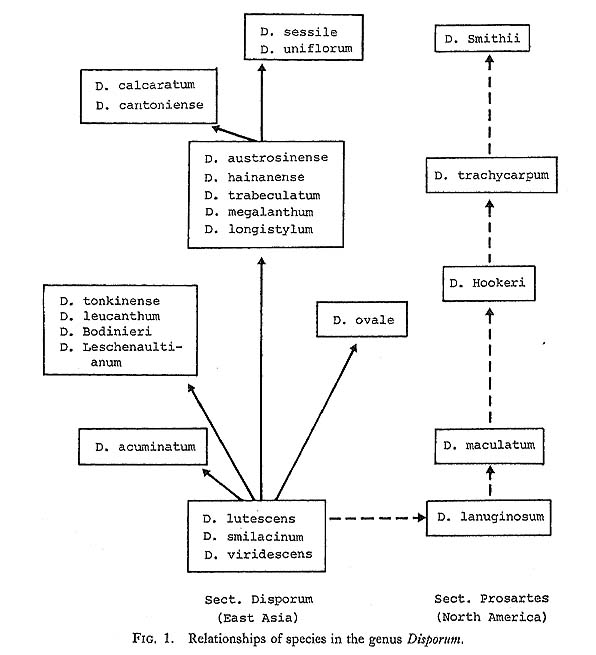
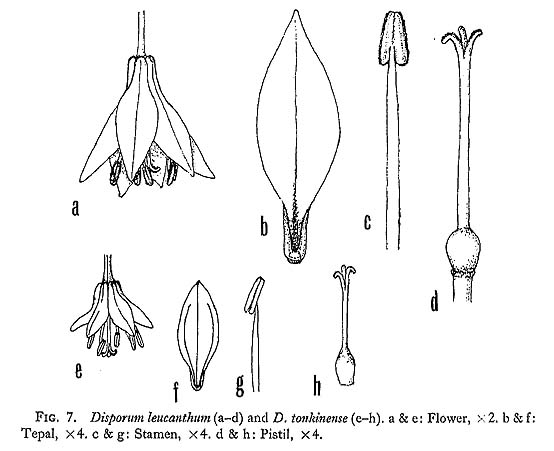
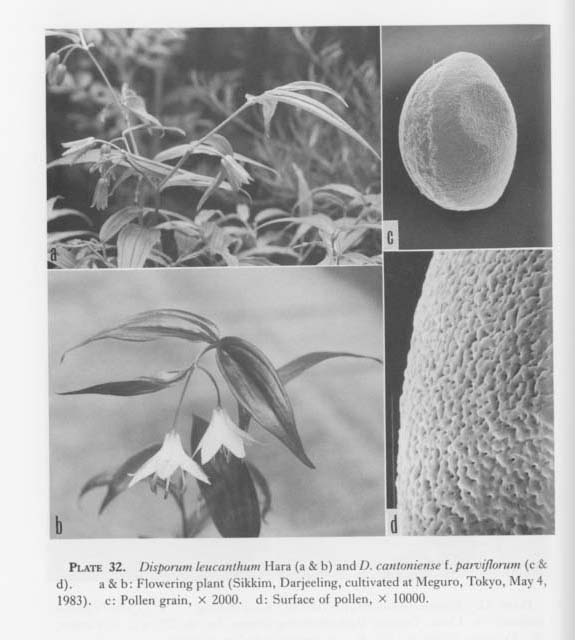
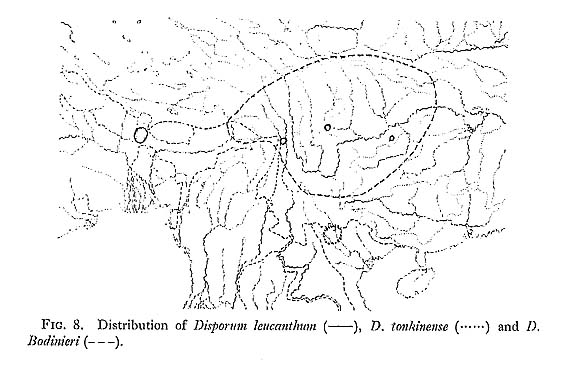
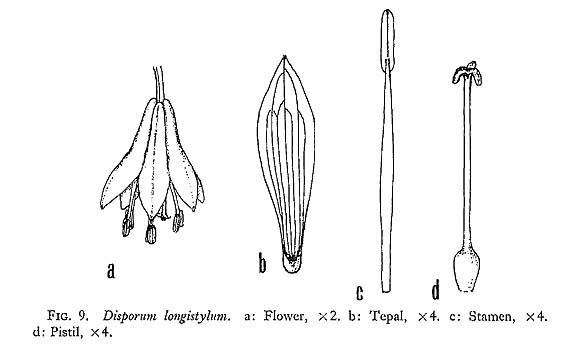

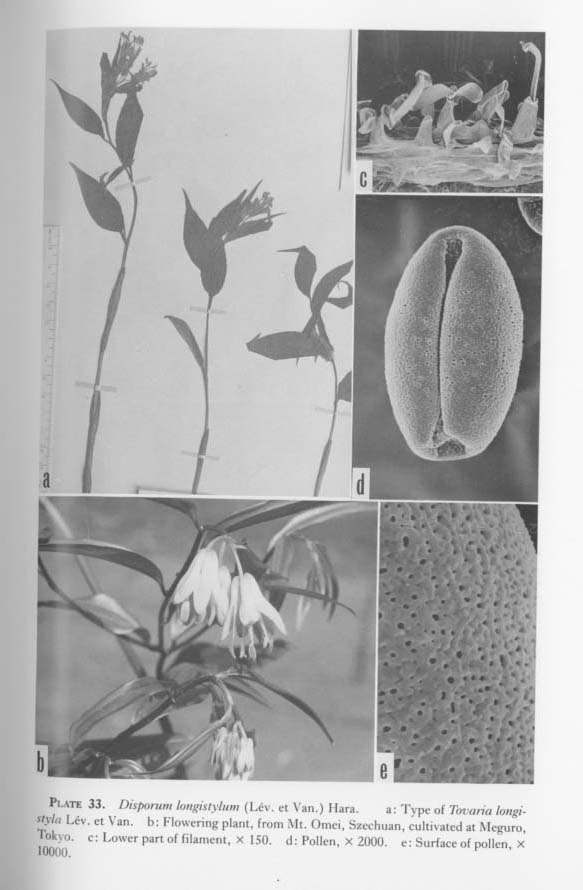
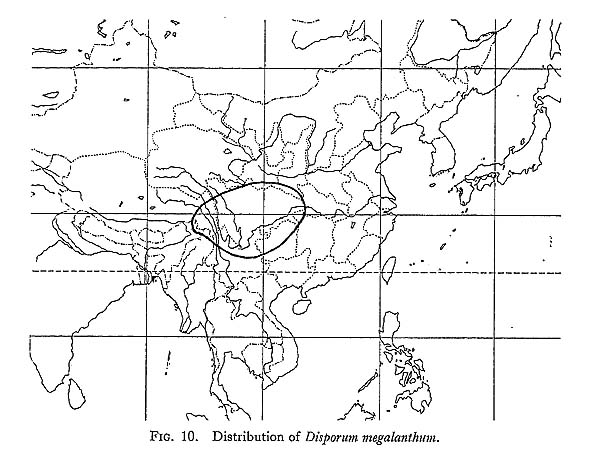

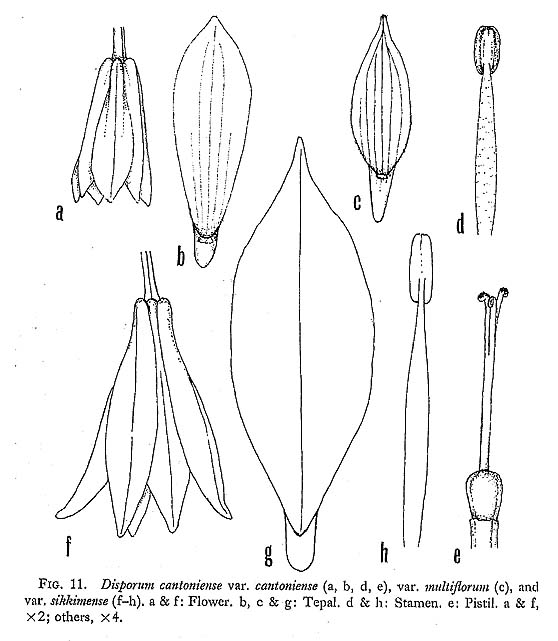
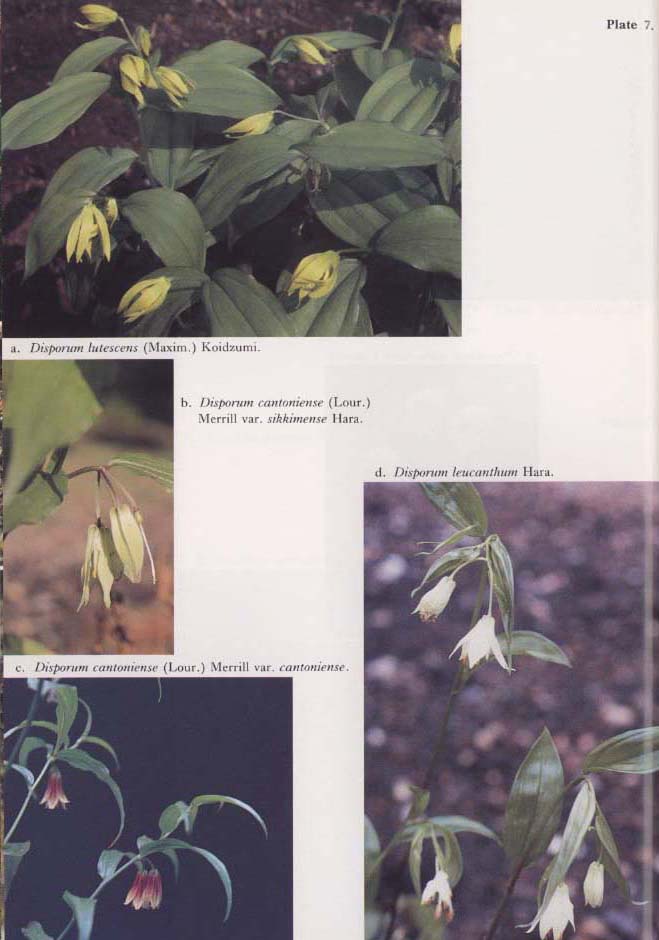
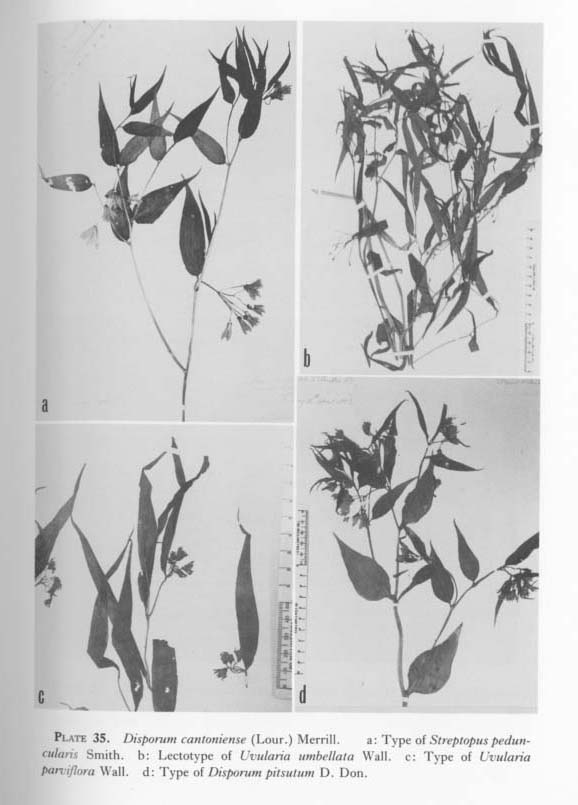

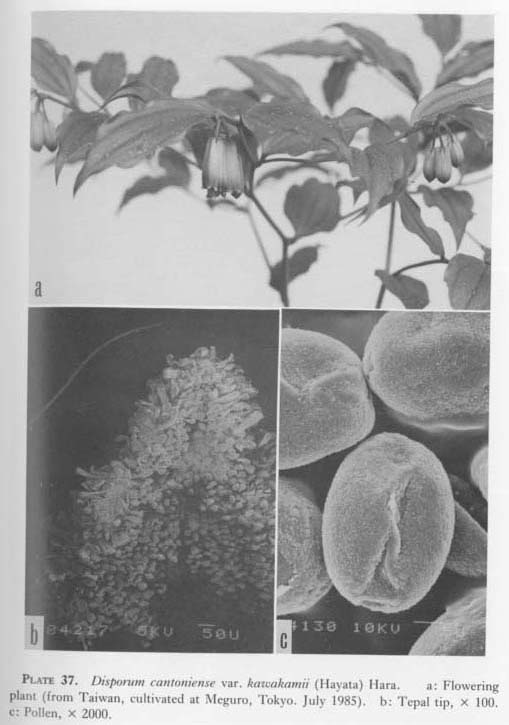

 , Yamamoto, cult. (M. Togashi, Jun. 17, 1962, fl., TI; cult. in Tokyo, H. Hara, May 30, 1963, fl., TI). SHIKOKU. Tokushima: Sakomura, cult. (J. Nikai no. 1239, Jun. 19, 1906, fl., TI).
, Yamamoto, cult. (M. Togashi, Jun. 17, 1962, fl., TI; cult. in Tokyo, H. Hara, May 30, 1963, fl., TI). SHIKOKU. Tokushima: Sakomura, cult. (J. Nikai no. 1239, Jun. 19, 1906, fl., TI).